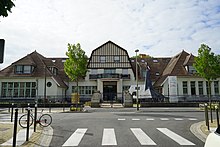Compagnons du Devoir

The Compagnons du Devoir (long form: Compagnons du Devoir du Tour de France et ) stands for a French craft - organization , as well as for members of the same.
Name derives from the guild or guild , since the Middle Ages (: tour of France to German) referred to is known as the Tour de France are moving years .
The community mediates and trains over ten thousand young professionals in the following trades every year:
Steinmetz , carpentry , roofing , installation , locksmith , blacksmith , carpenter , plasterer , painting and varnishing , Schweißere , mechanics , electricians , shoemakers , blacksmith , Gerber , Harnischmacher , upholsterers , gardeners , coopers , vintners , bakeries and pastry .
Only craftsmen from the Compagnons du Devoir are allowed to restore cultural and historical buildings such as the Notre-Dame , the Eiffel Tower or the Palace of Versailles in France . Some members of the Compagnons du Devoir receive the Meilleur Ouvrier de France (Best Craftsman in France) award every year .
Tour de France
The Certificat d'aptitude is a prerequisite for the Tour de France, in which the Compagnons are trained for three, five or seven years by the organization as part of its mentoring network in guild-owned hostels ( cayenne ) in order to learn from the Masters professional (certificate of professional competence). In order to be able to gather a wealth of experience, the Compagnons, which now include women, now move from hostel to hostel at intervals of six months to a year, of which there are at least 50 in France. Over the years, the craftsmen go through training phases: At first, the journeyman's piece (Chef-d'œuvre) must be accepted in order to be an aspirant . This designation will be kept for several years until the master thesis is submitted. Once they have passed, they are referred to as Compagnon ( compagnon itinérant , i.e. travel companion). After several years of work, they receive the title of compagnon sédentaire (sedentary companion), which on the one hand enables them to train themselves or be a teacher and on the other hand releases the companion into freedom. The Tour de France is now over if it is not decided to move again.
In the meantime, the association also promotes and organizes worldwide training tours for members.
history
By law Le Chapelier was journeyman Brotherhood banned from 1791 to 1864 in France.
During the German occupation of France in World War II , the Compagnons were persecuted due to a collaboration with the Freemasons , presumed by the occupiers .
Well-known Compagnons
- Agricol Perdiguier (1805-1875), carpenter.
- Adolphe Clément-Bayard (1855–1928), blacksmith
- Joël Robuchon (1945–2018), three-star chef or restaurateur and author
reception
George Sand wrote in 1840 the novel Le Compagnon du Tour de Franc e.
Web links
Individual evidence
- ^ Hugh Schofield: The French apprentices thriving on medieval roots ( English , article) BBC News. December 16, 2017. Archived from the original on December 17, 2017. Retrieved on December 17, 2017.
- ↑ Mark Traugott: Agricol Perdiguier . In: The French Worker: Autobiographies from the Early Industrial Era . University of California Press, 1993, ISBN 978-0-520-07932-8 , p. 116 (Retrieved November 25, 2015).